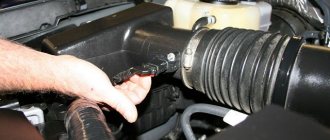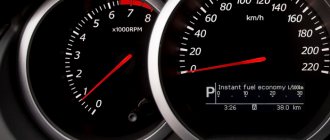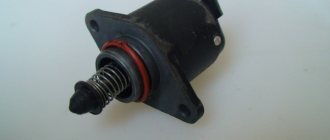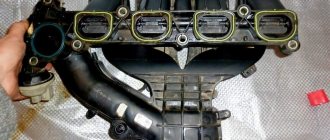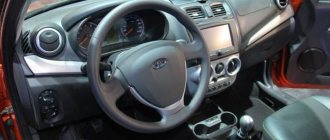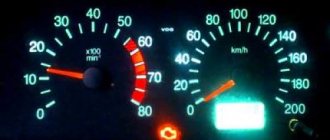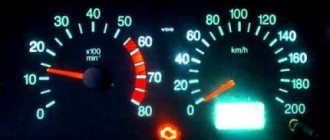It is very important that the engine operates correctly in any mode, including idling. However, many car owners are faced with a problem: when they release the gas, the engine speed does not drop. As soon as such a defect is discovered, it is necessary to immediately find out the cause and eliminate the malfunction for the smooth operation of the car. Also, the engine may slow down for a long time, which also does not contribute to proper operation.
Typically, upon reaching operating temperature, the speed should drop to its normal level. The manufacturer indicates the indicators for each specific vehicle model in the operating manual. They may vary slightly depending on the mileage and general condition of the car, but usually stay within the range of 650-1000 rpm.
In some cases, the speed drops very slowly or even stays at the same level of 1500-2000 revolutions. In this mode, not only does fuel consumption increase, which affects the driver’s finances, but it also contributes to engine wear.
The cause of the idle failure must be diagnosed by qualified technicians. However, you can also understand on your own why the engine speed does not drop.
Problems with the carburetor system
When releasing gas, the drop in speed can be bad for both injectors and carburetor systems.
If the car has a carburetor, then there may be several defects.
Most often, the speed does not drop due to a faulty throttle valve. When the engine warms up, it is in the open position to allow more air into the system. Then it closes and the speed should drop.
If the throttle valve is not closed completely, the mixture will still be over-rich when the operating temperature is reached, and the speed will remain at the same level. If this part is heavily soiled or deformed, it cannot close completely.
You can clean the damper using a special product, which can be purchased at an automotive supply store. Deformation may require replacing the carburetor completely. The damper may not close tightly if the drive cable is severely worn. Replacing it may improve the situation.
Another common reason why the engine speed does not drop when idling is the gasket between the carburetor and the cylinder head, which has become unusable, or a damaged intake manifold.
After replacing the carburetor or cleaning the power system, you can often notice that the engine speed is slowly dropping. This occurs due to improper adjustment of the idle system; an over-enriched air-fuel mixture is often supplied. To eliminate the malfunction, it is necessary to adjust the ratio of fuel and air supply to the system.
A high level of fuel in the carburetor float chamber can also cause a malfunction. The needle valve is responsible for it. Checking this detail may correct the situation.
Route map for eliminating unstable XX on a VAZ 2170
Unstable idle is caused by the fact that the computer incorrectly perceives or does not know at all the amount of air sucked into the intake manifold. A typical treatment recipe looks like this:
- Check the sensors (IAC, DFID, TPS) and replace the faulty ones.
- Make sure that the adsorber valve is in good condition.
- If, after cleaning the throttle valve on the VAZ 21126 engine, the speed fluctuates, you need to make sure that there is no air leakage through the connections to the pipes.
- Check whether the diaphragm in the vacuum brake booster is intact.
Experienced advice needed! Priora 2009 It began to spontaneously gain momentum... I’m standing at a traffic light and then once you hit 3000 and it doesn’t let up, I press the gas as much as I pressed and hold it, then it goes away on its own and so on 20 times a day!! I cleaned the throttle, changed the throttle position sensor, changed the idle sensor and nothing helps! Now, only when you roll in neutral, it still boosts up to 1200. What is the problem, has anyone encountered it?
I'm renovating and moving
by Adminrive Published 10/09/2016
As far as I understand, the firmware is stock
by Adminrive · Published 03/16/2017
Injector system
If your car has an injection system, there may be many more reasons for high idle speeds. Here, both mechanical elements and electronic devices responsible for adjusting the idle speed can fail.
The main injector malfunctions include:
- Incorrect operation of the temperature sensor installed in the cooling system. Incorrectly received data from this device causes the electronics to recognize the engine as cold and work to warm it up, thereby maintaining high speeds necessary to reach operating temperature. Overheating can often occur, which leads to more serious damage, including major engine repairs. The same effect is possible if the idle speed control is not operating correctly.
- The throttle control cable may become stuck. The higher the mileage of the car, the higher the risk of encountering a similar problem.
- The electronic XX operation sensor often malfunctions, then the speed will either increase or disappear altogether.
- The spring that brings the throttle valve to its original closed position is not functioning properly, is jumping off, or is being stretched too far.
- Too much air enters the fuel combustion chamber due to poor quality or leaky gaskets. It is necessary to carefully check the seals of the manifold and injectors.
- And the simplest reason is usually the incorrect placement of the mat after a visit to a car wash or dry cleaning of the interior. It is often inaccurately placed under the accelerator pedal, which leads to the appearance of improper engine operation.
Why does Lada Priora stall while driving when releasing gas?
With such a malfunction of the system, the following indications of its operation change: air and fuel consumption increases, its injection time changes, the idle speed control step increases to 75 units, the voltage at the terminals of electrical appliances changes.
A little about the reasons
The Lada Priora stalls while driving when releasing gas: the causes of this malfunction most often are a violation of the composition of the fuel mixture entering the car’s engine.
Having analyzed the methods of car owners of this car model to eliminate this malfunction, we can conclude that such a violation may be caused by improper operation of both the throttle system and some sensors and regulators. A complete diagnosis of the car at a car service center will help to identify the specific reason for the “floating” idle speed, although sometimes it is possible to find the source of the engine’s malfunction on your own. To do this, you need to sequentially disconnect or replace the following sensors and regulators with ones that are known to work correctly, removed from another vehicle.
So, let's figure out what to do first in case of such a malfunction.
Checking the operation of the throttle valve
Very often, the cause of idle “floating” is a malfunction of the throttle position sensor (TPS). The graphite track inside a standardly installed part wears out over time, so it is replaced with a sensor with a non-contact system. After replacement, you need to reset the sensor error. To do this, disconnect the terminals from the battery for 30 seconds or more.
It is also necessary to check the cleanliness and integrity of the pipe leading from the air filter to the throttle valve, and adjust the tension of the gas pedal cable going to it.
It is also possible that the gasket of the throttle assembly has become unusable or the assembly itself needs to be thoroughly cleaned (motor oil could have gotten into it) with special compounds for washing carburetors.
Changing the idle air control
Car service specialists admit that sometimes they have to spend a long time selecting a correctly working (despite the fact that it is new) idle air regulator to stabilize the idle speed of the engine. It is in this case that, before handing over your car for service, you should use an IAC regulator removed (temporarily) from a working car of the same brand.
It is advisable to replace the idle air regulator itself in conjunction with cleaning the vehicle's throttle system.
Replacing the mass air flow sensor
Determining the performance of this sensor (mass air flow sensor) is quite simple. You need to measure the voltage at its terminals with a multimeter with the engine off. It should be less than 1 volt. If it exceeds this value, then this sensor requires replacement.
Other reasons
In addition to the above malfunctions, Priora car owners resort to the following types of repairs to their car aimed at eliminating idle “floating”:
- replacing the knock sensor (DS) or crankshaft sensor;
- cleaning the speed sensor (DS), fuel grid or fuel filter;
- checking the integrity of the wires suitable for the sensors and the cleanliness of their terminals;
- adjusting fuel pressure or the operation of the vehicle's air intake system;
- increasing the power of the electric generator by adding another diode to its circuit;
- change the voltage regulator;
- adjust the correct operation of the absorber valve;
- check the carbon dioxide content in the fuel mixture and the correct functioning of the oxygen sensor (lambda), or turn it off programmatically;
- Reset the vehicle's electronic control unit (ECU). To do this, the battery is disconnected for a while, and then, after connecting it, the electronic system is “self-learning”;
- perform flashing of the car's electronic system.
In general, such a situation can arise even due to poor quality of the fuel being poured. In addition to changing the gas station, the fuel system may need to be cleaned.
The situation when the Lada Priora stalls while driving when releasing the gas can arise either for one of the above reasons or for a combination of them. Therefore, before purchasing new parts (to avoid unnecessary costs), it is recommended to diagnose the operation of the vehicle system at a car service center.
There is a special offer on our website. You can get a free consultation with our corporate lawyer by simply submitting your question in the form below.
Floating speed
In addition to slowly falling revs, car enthusiasts may encounter a phenomenon called floating revs, when they drop and then rise sharply. The reason is excessive air supply into the system, which causes the engine to spin up to 2 thousand revolutions at idle.
This often happens in cars that have a fuel injection sensor. It calculates how much air the mixture needs. When its operation is disrupted, different amounts of oxygen are supplied at different times, as a result, speed jumps are observed approximately every 3 seconds.
Faced with a similar phenomenon, the same computer diagnostics will be a prerequisite. It is very important that this and all subsequent work is carried out by experienced, qualified specialists. By contacting a service that does not specialize in breakdowns of this kind, you may be faced with the need to carry out an expensive overhaul of the engine ahead of time.
For normal engine operation and acceptable fuel consumption, it is necessary that all power unit systems operate properly. In this case, the engine should operate normally both under load and in idle mode.
In this article we will talk about why engine speed does not drop, and also consider the main reasons why such problems arise on carburetor and injection cars.
Read in this article
Why does Lada Priora stall while driving when releasing gas?
With such a malfunction of the system, the following indications of its operation change: air and fuel consumption increases, its injection time changes, the idle speed control step increases to 75 units, the voltage at the terminals of electrical appliances changes.
A little about the reasons
The Lada Priora stalls while driving when releasing gas: the causes of this malfunction most often are a violation of the composition of the fuel mixture entering the car’s engine.
Having analyzed the methods of car owners of this car model to eliminate this malfunction, we can conclude that such a violation may be caused by improper operation of both the throttle system and some sensors and regulators. A complete diagnosis of the car at a car service center will help to identify the specific reason for the “floating” idle speed, although sometimes it is possible to find the source of the engine’s malfunction on your own. To do this, you need to sequentially disconnect or replace the following sensors and regulators with ones that are known to work correctly, removed from another vehicle.
So, let's figure out what to do first in case of such a malfunction.
Checking the operation of the throttle valve
Very often, the cause of idle “floating” is a malfunction of the throttle position sensor (TPS). The graphite track inside a standardly installed part wears out over time, so it is replaced with a sensor with a non-contact system. After replacement, you need to reset the sensor error. To do this, disconnect the terminals from the battery for 30 seconds or more.
It is also necessary to check the cleanliness and integrity of the pipe leading from the air filter to the throttle valve, and adjust the tension of the gas pedal cable going to it.
It is also possible that the gasket of the throttle assembly has become unusable or the assembly itself needs to be thoroughly cleaned (motor oil could have gotten into it) with special compounds for washing carburetors.
Changing the idle air control
Car service specialists admit that sometimes they have to spend a long time selecting a correctly working (despite the fact that it is new) idle air regulator to stabilize the idle speed of the engine. It is in this case that, before handing over your car for service, you should use an IAC regulator removed (temporarily) from a working car of the same brand.
It is advisable to replace the idle air regulator itself in conjunction with cleaning the vehicle's throttle system.
Replacing the mass air flow sensor
Determining the performance of this sensor (mass air flow sensor) is quite simple. You need to measure the voltage at its terminals with a multimeter with the engine off. It should be less than 1 volt. If it exceeds this value, then this sensor requires replacement.
Other reasons
In addition to the above malfunctions, Priora car owners resort to the following types of repairs to their car aimed at eliminating idle “floating”:
- replacing the knock sensor (DS) or crankshaft sensor;
- cleaning the speed sensor (DS), fuel grid or fuel filter;
- checking the integrity of the wires suitable for the sensors and the cleanliness of their terminals;
- adjusting fuel pressure or the operation of the vehicle's air intake system;
- increasing the power of the electric generator by adding another diode to its circuit;
- change the voltage regulator;
- adjust the correct operation of the absorber valve;
- check the carbon dioxide content in the fuel mixture and the correct functioning of the oxygen sensor (lambda), or turn it off programmatically;
- Reset the vehicle's electronic control unit (ECU). To do this, the battery is disconnected for a while, and then, after connecting it, the electronic system is “self-learning”;
- perform flashing of the car's electronic system.
In general, such a situation can arise even due to poor quality of the fuel being poured. In addition to changing the gas station, the fuel system may need to be cleaned.
The situation when the Lada Priora stalls while driving when releasing the gas can arise either for one of the above reasons or for a combination of them. Therefore, before purchasing new parts (to avoid unnecessary costs), it is recommended to diagnose the operation of the vehicle system at a car service center.
There is a special offer on our website. You can get a free consultation with our corporate lawyer by simply submitting your question in the form below.
Floating speed: reasons
Note that in some cases the revolutions do not just slowly fall or remain at the same level, but “float”. In this case, the engine may become unstable. Floating speeds first fall, then increase sharply and everything repeats. A common cause of this phenomenon is the supply of excess air, which leads to “jumps” in speed at idle.
If malfunctions occur, the control unit cannot prepare the “correct” mixture for the idle mode, which causes speed jumps after releasing the gas pedal or when the engine is idling.
The beginning of problems
If you unexpectedly discover that the idle speed in your car is floating, not only do you not need to panic, but generally be nervous. This nasty thing can occur both on cars with a carburetor engine and on models with an injection engine, and most importantly, sometimes even decent foreign cars, not to mention domestic models, do not avoid this fate.
The only difference is in the fuel injection system and, accordingly, in the methods of eliminating this trivial nuisance. But, since we decided to consider the problem from the point of view of modern Priora and/or Kalina, then we will have to evaluate the injection version of the engine with the so-called electronic fuel injection.
How it happens in reality
However, the situation can develop completely differently: sometimes these surges can just as suddenly disappear after a short warm-up of the engine, but it also happens the other way around - you’ve been driving for a long time, you stop at a traffic light, for example, and then pandemonium begins.
What's the matter
There may be several reasons for this disgusting and inappropriate behavior. We will list all possible situations when the idle speed fluctuates.
- The electronic control unit of the car (on-board computer), called the “brains,” has “gone crazy.” Simply put, the system caught a glitch.
- The throttle position sensor is broken.
- The temperature sensor brazenly “lies”, showing that the engine has long warmed up and is ready for maximum load, which means it no longer requires increased fuel supply.
- If there are increased idle speeds, then it is likely that the crankcase ventilation valve has closed.
Well, of course, we should also mention the carburetor. Basically, the idle speed fluctuates only on those cars on which some “skilled person” got into the carburetor itself (removed it, for example), and then just as “skillfully” put it back in place, knocking down the setting and tightening something not this way.
By the way, if we take diesel engines as an example, then everything could not be simpler and the reason for the floating speed is the jamming of the blades in the pump, which occurs due to primitive rust. That is, you remove the rust from the blades and the speed returns to normal.
Replacing the rear engine oil seal
How to behave and what to do
- Check the speed adjustment screw and simply tighten it if necessary. This way you will close the hole through which the air escapes.
- Using regular pliers, pinch the fuel pipes one by one. This way you can determine which one has a crack or even a hole.
- Check the crankcase vent valve for opening/closing. It is quite possible that it also does not work stably.
- Be sure to look at the operation of the throttle valve. If it doesn't open on time or doesn't close on time, then naturally the problem is here.
- Finally, having not found a single violation in the first four points, you can be sure that the cause of the floating speed was the “lying” on-board computer, that is, the “brains” of the car and the error can be eliminated either by having a special tester on hand, or after all by visiting a repair shop, where the error will be removed.
Recommendations
In addition to the above, don’t be lazy and also check the spark plugs, the wires going to them and the distributor. This does not greatly affect the speed, but in total it can bring a positive result.
I heard that on many Priors the idle speed fluctuates when the car is warmed up. So I was ready for this.
) Not always, but sometimes they float, and it’s annoying... Especially if you also turn on the headlights, rear window heater and heater, then the swimming range becomes even greater (from about 800-1000). Maybe still a break-in, although I heard that after 10.
000 thousand mileage, this kind of garbage also happens... If anyone had or still has the same problems, or maybe someone knows what to do about it, write and we’ll discuss it.
Let's sum it up
As you can see, in order to accurately determine why the engine speed is not reset, in many cases in-depth diagnostics may be necessary. For carburetor engines, cleaning and adjustment of the carburetor itself is often necessary, while the injector will require computer diagnostics.
If the problem is not on the surface (the throttle cable has become sour, after washing or dry cleaning, the carpet in the cabin is not installed correctly, which presses the gas pedal, etc.), then it is better to take the car to a service center.
The most complex situation is when the design of the power system involves the presence of a large number of sensors and actuators. In this case, even the use of diagnostic equipment does not always allow you to quickly and accurately determine the problem.

